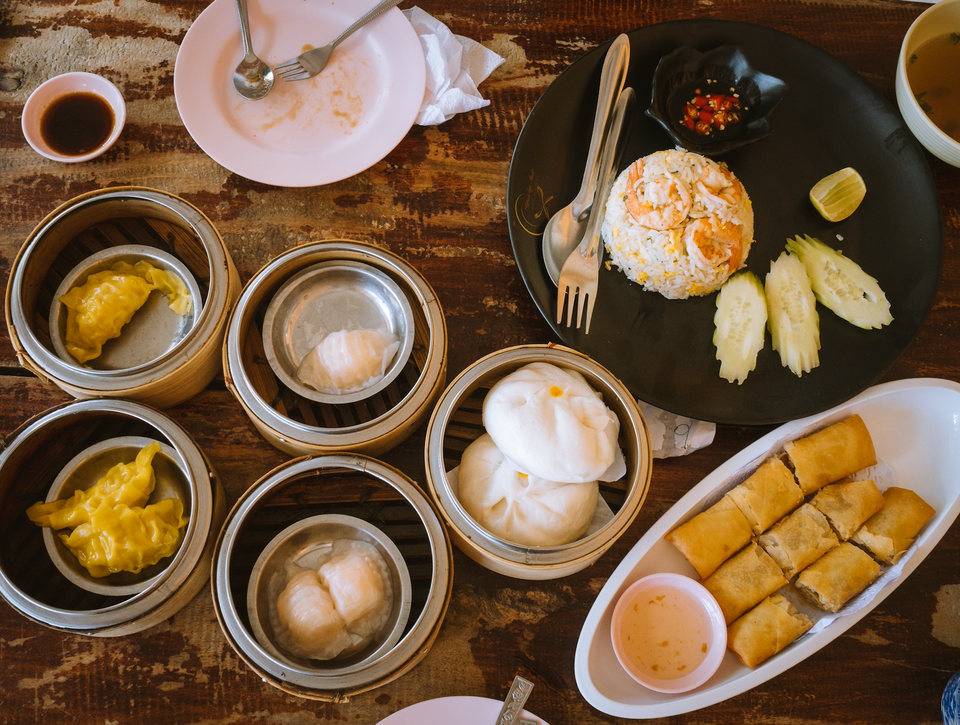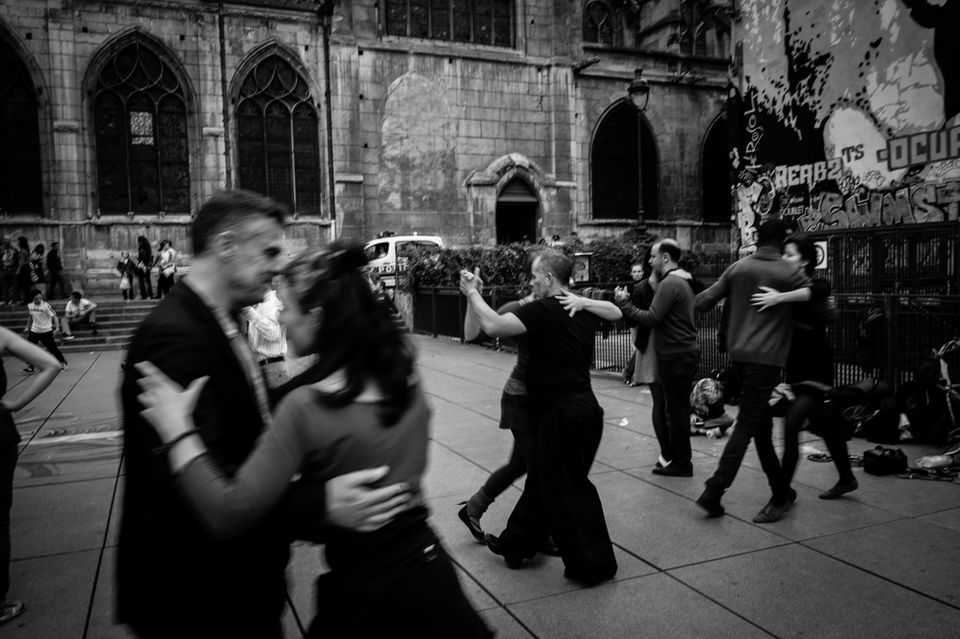Every day at 7:15AM my wife and I enter the red line station at the corner of Sheridan Road and Loyola Avenue. We are part of a steady stream of commuters that enters through the doors and immediately turns right toward the turnstiles. But every once in a while, someone turns left. Cutting back across the flow of the throng, eyes averted, it’s a sure sign that they’re headed to the other end of the station—to Dunkin’ Donuts. Each day this moral drama runs its course anew. Those with the requisite self-control step to the right; those weakened by stress, a sleepless night, or low blood sugar step to the left, and, to the demise of their diet, receive their temporary delight.
To be fair to my fellow commuters, the cards are stacked against us. Like some citywide sting operation by the calorie Gestapo, a Dunkin’ Donuts seems to be near every single train station in Chicago. Many commuters face this lipid-laden temptation four times each day. For me, and I’m sure for others, the Dunkin’ Donuts sign is no longer inviting, but remains a reminder that my health and waistline are permanently under siege.
No doubt a similar drama plays out on countless street-corners in every city in America. It might not be Dunkin’. Perhaps it is the siren song of Krispy Kreme’s “Hot Now” sign—the drama remains the same. In the face of a 24/7 offer of doughnuts, we are no longer rational, decision-making human beings, but urge-ridden troglodytes bound to our inborn drive for fat and sugar.
What about the time before America ran on Dunkin’? Wasn’t there a way to do doughnuts right? Weren’t there doughnut places left over from a time before our McDonaldization, places built to offer quality rather than mere availability? I quickly discovered that precious few such places exist, even in a city the size of Chicago. The small, independent doughnut shops I found could be counted on one hand. Almost none of them were actually old. In other words, they weren’t survivors—they were revolutionaries. These shops opened specifically to offer something fresh and different in a market dominated by the fast food practices of the major doughnut chains. I began to get hints that the doughnut story was not so much a story of extinction as a story of rebirth.
As I scoured the city in search of a different kind of doughnut, I decided to conduct an informal experiment. I simply mentioned to friends, family, and co-workers that I was writing an article about doughnuts and waited to see what reactions would follow. Most laughed good-naturedly, as if to say that I was being silly in examining something not worthy of my attention. Many other people, however, were more derisive. They seemed threatened by what they took to be a ploy to intellectualize something that was actually inane, or even disgusting: the food of choice for Homer Simpson and overweight cops. This further motivated me to discover what I believed would prove them wrong.
Fittingly, the first shop that caught my attention was named Do-Rite Donuts. Do-Rite has a simple mission: to offer the freshest doughnuts possible every single hour they are open. To achieve this goal, Do-Rite makes their doughnuts in small quantities—never more than 36 per batch—with chefs continuously at work in the kitchen. Do-Rite usually sells out of their daily stock in the early afternoon, though one employee mentioned that they have closed as early as 11am. Do-Rite’s menu changes every day of the week with lots of seasonal specials like the cinnamon and sugar old fashioned doughnut topped with cream cheese, baked apples, and caramel sauce that is only offered during the holiday season.
Despite Do-Rite’s proclivity toward striking combinations (orange and rosemary, or the peanut butter and jelly doughnut, for example) I prefer their handling of the classics, like their Boston creme topped with slivered almonds, or their simple old fashioned variety that is so crispy it crunches like popcorn when you bite into it. For a few hours every morning business people headed toward the enormous state building surrounding Daley Plaza can be seen with Do-Rite bags in hand. Do-Rite’s only location at 50 W. Randolph Street is so tiny that I found it impossible to locate using the Google Maps street-level view. Even standing across the street, I had to squint to distinguish Do-Rite from the larger restaurants that surround it.
Another establishment in River North, Doughnut Vault, is even smaller than Do-Rite. On my first trip to Doughnut Vault I waited over half an hour in line. My second time, in an attempt to beat the line, I arrived the minute Doughnut Vault opened only to find that a long line of people were already waiting. Inside, Doughnut Vault is true to its name; the cramped interior has been converted from an old bank vault. It is surprisingly cozy. Its thick stone walls have soft lighting and lead to a single cashier behind an antique brass cash register.
The infinitesimal Doughnut Vault sits in the shadow of the Merchandise Mart, one of Chicago’s most imposing structures that, when it opened its doors in 1930, was the largest building in the world. Until 2008 it had its own zip code. Nevertheless, unlike most of the space that surrounds it, Doughnut Vault has opted to focus on quality rather than availability: the doughnuts sell out shockingly fast, sometimes within two hours of their 8am opening time. Due to the extremely small supply and intense demand, Doughnut Vault’s staff communicate with their over 7,700 followers on Twitter, tweeting announcements like, “Good morning everyone! We are open! Today’s special is pistachio glazed. Hurry in and get in the front of the line!” and “Out of gingerbread stacks!! 6 dozen old fashioned, 1 dozen chocolate, 3 dozen chestnut, 5 dozen vanilla! About 15 people in line!”
Doughnut Vault’s selection seems based on the motto, “If it ain’t broke, don’t fix it.” Each of their seven types of doughnuts is simple and excellent. My favorite is the blackberry jelly doughnut, which is really filled with something more like fruit sauce to be served with a piece of cheesecake than what the word jelly implies. A major crowd pleaser at Doughnut Vault, however, is the plain but enormous glazed doughnut, which is so large it is difficult to eat with one hand.
I was even more astounded by Glazed and Infused. Situated in the west loop, Glazed and Infused sits on a landscape born out of a process of urban renewal. What was once a tired and outdated industrial section of the city has in the last decade become a vibrant community, boasting some of Chicago’s finest bars and restaurants. Like its neighborhood, Glazed and Infused is taking old forms to unforeseen heights. One great specimen, for example, is the crème brûlée doughnut. With all of the traditional elements of a crème brûlée (crème inside and carmelized sugar shell on the outside of the pastry) this creation pushes the limits both in terms of culinary techniques as well as class-conditioned notions of what kind of food the doughnut is and who it is for. Several other creations at Glazed and Infused, like the carrot cake doughnut and egg-nog bourbon doughnut, play upon the same set of distinctions between high and low culture.
Along with the many miles I walked and the innumerable calories I ingested on my quest for a different kind of doughnut, I began to look for answers as to why this pastry that is so celebrated popularly had become so reviled publicly. I came across the following story that I believe speaks volumes: One legend has it that the doughnut was born when a ship captain named Hanson Gregory became dissatisfied that his olykoeks (Dutch: “oily cakes”) never seemed to cook all the way through. In a flash of inspiration he removed the top of his ship’s tin pepper jar and used it to cut out the center from the dough. What I love about this story is that the distinctive feature of the doughnut turns out not to be its taste, its ingredients, or even its national origin, but rather a simple act of ingenuity.
For many, doughnuts symbolize our basic inability to reconcile our exorbitant desires (Supersize it!) with our aspirations for perfect health, long life, and ideal bodies. But, I believe there is more to the doughnut. I am reminded of what W.E.B. Du Bois said in describing American art and music: “Little of beauty has America given the world save the rude grandeur God himself stamped on her bosom; the human spirit in this new world has expressed itself in vigor and ingenuity rather than in beauty.”
Doughnuts are not a refined food (unless we’re talking about refined sugar), but perhaps it is this feature that makes them all the more distinctively American. Perhaps it was because doughnuts captured the spirit of American ingenuity that millions of them were shipped to American soldiers in the trenches in World War I and why doughnuts were billed as the “the food hit of the Century of Progress” at the 1934 World’s Fair, right here in Chicago. Even as we move away from the fast food model and the havoc it has wreaked on the American way of life, perhaps in re-engineering doughnuts we can bring that essential part of what captured the imagination of past generations with us.
So I’m looking forward to the future of the doughnut in America. Maybe the trend will continue to catch on, and maybe—we can’t be sure—we will remake and rediscover ingenuity. In the meantime, as I enter the train station, I’ll keep stepping to the right.



